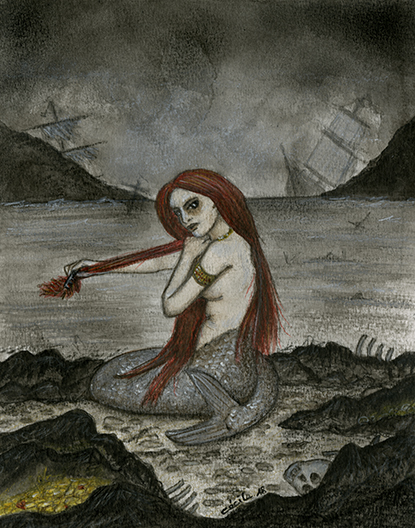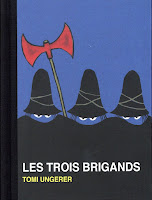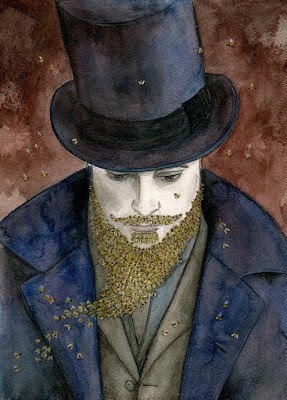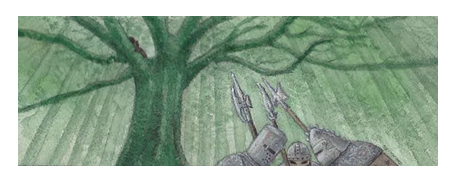Cécile Matthey (portfolio) is the artist who has been with The Future Fire for the longest; her first illustration for us was in issue #6 (2006), and she has been featured as cover artist ten times. She is now also an assistant editor of the magazine, and was co-editor of the anthology TFF-X: Ten years of The Future Fire. So let's find out more about her work, her influences, and the woman behind those sometimes fiendish, sometimes playful, always delightful illustrations!
Cécile, can you show us and talk us through a few of your illustrations for TFF of the last few years?
All three illustrations I have chosen show the protagonists of the stories: a mermaid, Gennesee, and Shuuran/Kuroba Ren. They look very different, but in the end, all of them are strong, unusual, gifted or cursed, and often lonely. The first two are closely inspired by artworks of the 19th /early 20th century.
 |
| The mermaid (Illustration for « Mermaid’s Comb » by Colleen Anderson TFF 2018.45) |
This siren combing her hair is based on a famous painting by John William Waterhouse (1900). It is the archetype of the siren to me, so it was quite natural to take it as a reference here. To match the dark and evocative atmosphere of Colleen’s poem, I represented her as a sinister, vampire-like creature, surrounded by the bones of the sailors she lured. The whole atmosphere is grey and stormy, and we can see wrecked ships in the distance. The only colours are the glittering gold she has gathered and her bright red hair. Waterhouse, whom I discovered during a summer English course in Oxford, is one of my favourite artists, especially for his works depicting legends and classical myths. Funny enough, his painting was also inspired by a poem: “The Mermaid” by A.L. Tennyson.
The portrait of Gennesee comes from another archetype: the red-haired poetess illustrated by Eugène Grasset on an advertising for the ink brand Marquet (1894). It was fun reinterpreting this classic Art Nouveau figure as a black woman with piercings and long flowing braids, keeping the antique dress, the quill, and the ink bottle. Something in this lovely story by Hayley Stone reminded me of Edgar Poe, so I copied a few verses from The Raven on Gennesee’s arms, to show the deathly poetry literally flowing under her skin. But you must look very closely at the illustration to see it!
“The Boy from the War” by Perrin Lu is an eventful, almost cinematic, story. Actually, it was difficult for me to decide which moment to illustrate. So, I chose to show something happening “between the lines”: Shuuran/Kuroba Ren in a moment of calm, meditating before her fight against Gohei. In the background, we can see the demon mask she will use to (once again) hide her identity. Preparing the illustration, I looked for visual references on the web and was surprised to find 19th century photos of real Japanese samurai women. They didn’t inspire me directly, but they probably influenced what I imagined the protagonist could look like.

 Let's talk about you for a bit, then. What is your favourite illustration from the last ten years?
Let's talk about you for a bit, then. What is your favourite illustration from the last ten years?
I have a soft spot for the witches on the poster of the play Trois soeurcières (“Wyrd sisters”) by Terry Pratchett (Théâtre de la Cité, Fribourg/Switzerland, 2018). My inspiration came from a children’s book called Les trois brigands, illustrated by Tomi Ungerer. I loved it then but dreaded it too, because the cover was very impressive to me. I enjoyed reinterpreting it here, about 40 years later.
How has your work matured or evolved in the eight years since you last visited us here at the Press Blog?
It’s always difficult to analyze one’s own work. On the whole, I’d say the illustrations are a bit more elaborate. The colours are richer and stronger, I tend to use more mixed media, the themes and points of view are more varied. I always enjoy exploring my personal references (books, paintings, films…) and twisting them to produce something original. The woman illustrating the poem « Daughter » by Eva Papasoulioti (TFF 2019.51), for instance, is inspired by a 19th century brooch; the dark siren of “The mermaid’s comb” (discussed above) is a parody of the painting by J.W. Waterhouse, etc.
 Is there a painting or illustration in which you have always dreamed to enter? What would it be like in there?
Is there a painting or illustration in which you have always dreamed to enter? What would it be like in there?
When I was a child, I used to spend the summer holidays in a chalet
in the Swiss Alps. Above my bed there was a reproduction of “La route
aux cyprès” by Van Gogh. I was fascinated by it, wondering if it was a
kind of dream: there seemed to be a moon and a sun together, and the
whole picture seemed to undulate and palpitate. I would have liked to go
to the cypress to have a better look. Surely I would have felt dizzy in
there, like after watching too much static on a TV screen… or drunk too
much wine.
Could you imagine challenging yourself by illustrating something in a completely different medium from usual?
I like etching and its various techniques, that can create stunning visual effects. But it demands a lot of practice to achieve something good. Collage, combined (or not) with drawing or painting, could be another option. I discovered this technique last summer and loved it. It’s more spontaneous than “classic” illustration, and the graphic possibilities are numerous. I think I’ll give it a try in a future TFF assignment.
 Who is the artist who has surprised you the most? (By using an unexpected technique or medium, for example, or by creating work outside of the style you associate with them.)
Who is the artist who has surprised you the most? (By using an unexpected technique or medium, for example, or by creating work outside of the style you associate with them.)
 At secondary school, I gave a presentation about Pop Art. It was a small revolution to me: art was not just academic and “boring” but could be colourful, inventive and fun. I have vivid memories of an exhibition I saw in Geneva at the time, showing works by Andy Warhol, Roy Liechtenstein and Jeff Koons. His “inflatable” metal rabbit is still a favourite of mine today. And more recently, I discovered Christoph Niemann, who makes everyday objects (an ink bottle, a sock, a hammer…) part of his illustrations. It’s very inventive and fun too!
At secondary school, I gave a presentation about Pop Art. It was a small revolution to me: art was not just academic and “boring” but could be colourful, inventive and fun. I have vivid memories of an exhibition I saw in Geneva at the time, showing works by Andy Warhol, Roy Liechtenstein and Jeff Koons. His “inflatable” metal rabbit is still a favourite of mine today. And more recently, I discovered Christoph Niemann, who makes everyday objects (an ink bottle, a sock, a hammer…) part of his illustrations. It’s very inventive and fun too!
Is there a story you would always have liked to illustrate?
Illustrating Treasure island by R.L. Stevenson has always been
a dream of mine. It’s a big and challenging task… I’ll get down to it
when I’m retired, maybe ! In the meantime, I’d love to explore classical
mythology, for instance, or illustrate a “Victorian” story, like The picture of Dorian Gray or a book by Jules Verne. It could also be interesting to work on something darker : a vampire story, for example.
 Is there a painting or illustration (by another artist) that you think really represents you, or some aspects of your personality?
Is there a painting or illustration (by another artist) that you think really represents you, or some aspects of your personality?
I like this illustration by W. Siudmak, showing a paper-winged angel seated on the edge of a rock floating in space, holding a small revolving planet. It could represent my constant search for balance and beauty in this unstable world, with a feeling of fragility, a kind of innocence, and a fertile, creative imagination, of course.
Finally, can you give us a taste of a few of your artworks that won’t be found in the pages of TFF? What sort of thing have you been illustrating elsewhere?
 |
| Lord of the bees |
I made this portrait for Belinda Draper (author of “The Bright Hunters” – TFF 2015.33), who bought a custom illustration from me in the TFF-X fundraiser in 2015. She asked me to illustrate her story “The honey tree,” a lovely reinterpretation of the fairy tale “Bluebeard”. I was given “carte blanche,” so I chose to represent the protagonist Beebeard as a styled dandy, with a top hat. Drawing each bee individually demanded some patience! I was planning to take the illustration to Belinda in person in Australia, but this project had to be postponed because of the burns and then the Covid pandemic.
 |
| Hiding in the tree |
This illustration was made for a friend of long standing, Gaëlle Vadi, who wrote a great fantasy epic called Le retour d’Achal Kaalum (“The return of Achal Kaalum”) in the early 2000s. I have been illustrating it since 2004, very irregularly. It’s a real long-term task! But we hope to publish it one day, somehow… Here, we can see Anders, one of the protagonists, hiding in a tree from dire assassins. Their arms are a mix of Viking, medieval and fantasy elements. This illustration is the frontispiece of the chapter, which explains its unusual oblong format.
 |
| The fish tree |
Another collaboration, and… another mermaid! The photo was taken by my friend Rachel Rumo, a nature-lover and long-distance tripper. She asked me to let my imagination wander around it on the passe-partout. In 2007, we held a whole exhibition together with such “hybrid” works in Romont (Switzerland), which was an unexpected success. This one, a siren watching a naked tree growing fish, was made in 2018 to celebrate the 30th anniversary of the exhibition hall, located in a medieval tower called “la Tour du Sauvage.”
Thank you so much for stopping by, Cécile. See you again soon in the pages of the magazine!













